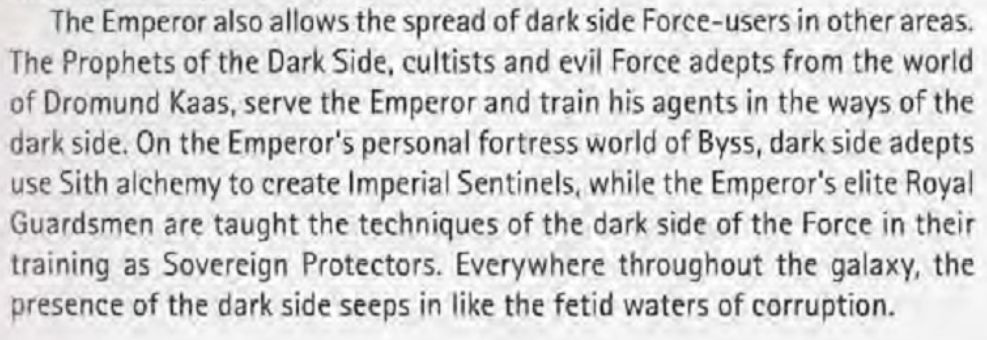If you take a closer look at Emperor Palpatine’s inner circle, you’ll notice something odd: the most powerful Sith Lord in the galaxy, a master of the dark side, is always surrounded by non-Force-sensitive guards.
Whether it’s the crimson Royal Guard standing silently at his side or the elite Death Troopers enforcing his will, Palpatine never put his life in the hands of fellow Force-users. For a leader obsessed with control, power, and survival, this wasn’t just a coincidence—it was a calculated move. So why did Palpatine trust ordinary mortals with his protection instead of his own dark side disciples?
1. Using Force-sensitive as Imperial Guards Would Be a Waste or Put Palpatine At Risk
By the time Palpatine declared himself Emperor, the age of powerful Force-wielders was over—and he was the reason why. Order 66 wiped out almost every Jedi, and the few survivors were relentlessly hunted by Vader and the Inquisitors. With most Force-sensitives either dead, in hiding, or broken, there just weren’t enough trustworthy or skilled candidates left to serve as Imperial bodyguards.
If the Imperial Guards had been Force-sensitive, they’d almost certainly have been trained in the dark side—and we all know how the Sith operate. Betrayal is practically a tradition. Sith history is a long story of apprentices turning on their masters, and Palpatine’s whole rule was built on mistrust and manipulation. The only thing more dangerous than a Jedi was a potential dark side rival standing right next to you. Giving a Force-sensitive that close access, no matter how loyal they seemed, would basically be inviting disaster.
That’s why, after wiping out the Jedi, Palpatine also moved to eliminate other Force-sensitive groups, like the Nightsisters of Dathomir.
In the canon comic Darth Maul: Son of Dathomir, we really get to see just how wary Palpatine was of any Force-wielders who might threaten his power. Early in the series, we pick up right after Palpatine captured Maul in The Clone Wars, and it becomes clear that the Emperor’s real goal was to use Maul to lure out Mother Talzin. Palpatine shares his reasoning with Dooku, saying,
“There are many Forces poised against us. To ensure our complete and total victory, we must root out and destroy all of our enemies.”
Dooku asks, “You speak of enemies other than the Jedi?”
Sidious answers, “I speak of that Dathomir Witch—Mother Talzin.”

By the end of the comic, Mother Talzin meets her fate at the hands of Count Dooku, General Grievous, and Palpatine himself. This moment says it all: Palpatine wasn’t just eliminating Jedi—he was erasing any Force-sensitive rival who could possibly threaten the Empire. His fear of Force-wielders wasn’t just paranoia; it was a calculated move to make sure no one but him ever held true power in the galaxy.

2. Force-Users Were Never Trusted to Protect the Emperor
Another key reason is that Force-sensitives could pose a direct threat to Palpatine and his hold over the Empire. He already had the most powerful Force-user imaginable at his side—the Chosen One, Darth Vader. If Palpatine surrounded himself with even more Force-sensitives as guards, he’d be opening the door to serious danger. After all, we often see two Imperial Guards standing right beside the Emperor. If they were Force-sensitive and ever decided to betray him alongside Vader, Palpatine would suddenly be facing not just one, but multiple Force-wielding enemies in his own throne room. The odds of a successful coup would skyrocket.
That’s exactly why the Inquisitorius, despite being trained Force-users, were never stationed as Palpatine’s personal guards. Instead, the Inquisitors served under Vader’s command, far away from the Emperor’s inner circle. Palpatine was careful to keep all other Force-sensitives at arm’s length—close enough to be useful, but never close enough to become a threat.
Bonus: Force-Sensitive Royal Guards Did Exist in Star Wars Legends
While Palpatine avoided using Force-sensitive guards in canon, Star Wars Legends introduced several examples where he experimented with exactly that. In these stories, the Emperor’s search for the ultimate personal protection led him to train select Royal Guards in the use of the Force, creating elite bodyguards who were more than just skilled soldiers.
One of the most well-known groups is the Imperial Sovereign Protectors. These were an elite order of Royal Guards who received advanced training in the dark side of the Force directly from Palpatine. More than just ceremonial guards, the Sovereign Protectors were chosen for their unwavering loyalty, combat skill, and latent Force sensitivity.
What we have proof of is from the Star Wars The Force Unleashed Campaign Guide, the book describes it “The Emperor also allows the spread of dark side Force-users in other areas. The Prophets of the Dark Side, cultists and evil Force adepts from the world of Dromund Kaas, serve the Emperor and train his agents in the ways of the dark side. On the Emperor’s personal fortress world of Byss, dark side adepts use Sith alchemy to create Imperial Sentinels, while the Emeperor’s elite Royal Guardsment are taught the techniques of the dark side of the Force in their training as Sovereign Protectors.”

They donned the familiar crimson armor, but their abilities went far beyond that of the standard Guard—they could wield Force powers like telekinesis, mind tricks, and even limited precognition. The Sovereign Protectors served as both elite bodyguards and enforcers, and some sources even suggest they acted as advisors and attendants in Palpatine’s inner court. This group appeared in various Legends sources, including the Dark Empire comic series and Star Wars roleplaying game materials.
Palpatine’s secret project, the Shadow Guard, also appeared in the video game The Force Unleashed. These elite guards wielded double-bladed lightsaber pikes and could use basic dark side abilities.

They were deployed as special enforcers and bodyguards, but even then, Palpatine never fully trusted them, using them more as expendable weapons rather than true protectors.

